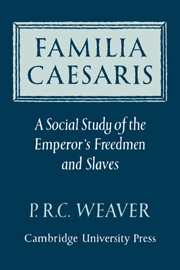PART III - THE EMPEROR'S SERVICE
Published online by Cambridge University Press: 07 October 2011
Summary
From the end of the first century, and certainly from the time of Hadrian, recruitment into the various services of the Familia Caesaris was predominantly from within the Familia, from the children, and especially the sons, of the Caesaris servi and Augusti liberti themselves. This is indicated especially by the increasing use of the term verna in the status indication of Imperial slaves in the second century. Recruitment from within, it has been argued in a previous chapter, is compatible with the predominance of ingenuae among the wives of the Caesaris servi only because of the application of the SC Claudianum.
In the first century, however, slaves entered the Familia Caesaris in considerable numbers from outside. This inflow can be directly traced in all periods up to the time of Hadrian by the agnomina in -ianus derived from the previous owners. They are particularly apparent in the period of Augustus and Tiberius. The methods of acquisition were the same as those by which the emperor's patrimonium in general was increased – gift, bequest and legacy, and, no doubt exceptionally in the case of slaves, even purchase and confiscation.
A further source of recruitment was through the slaves of Imperial slaves themselves, vicarii, who were in law strictly always the property of the emperor – and thence, as what may be called ‘vicariani’, into the Familia Caesaris itself.
- Type
- Chapter
- Information
- Familia CaesarisA Social Study of the Emperor's Freedmen and Slaves, pp. 197 - 199Publisher: Cambridge University PressPrint publication year: 1972



